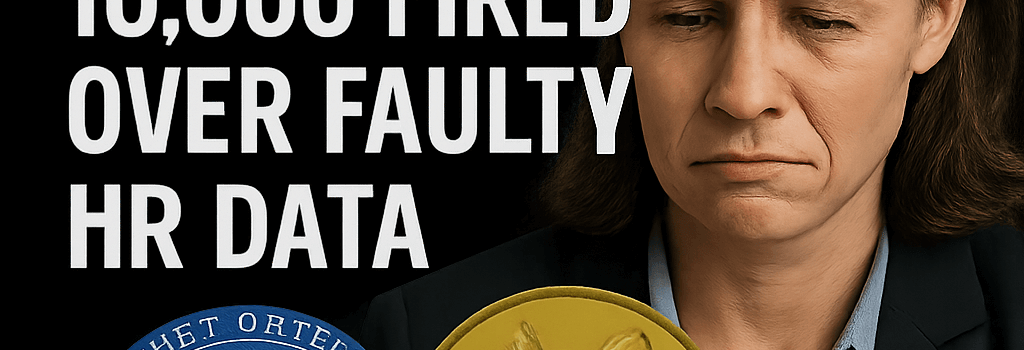HHS and DOGE Lawsuit: 10,000 Fired Over Faulty HR Data

Summary: A recent class-action suit claims the US Department of Health and Human Services (HHS) and the Department of Government Efficiency (DOGE) used error-ridden personnel records stored across siloed systems to execute an April 1 reduction in force (RIF) that cut 10,000 federal employees. This article expands on the lawsuit’s technical allegations, explores how data governance failures occurred, and examines expert-recommended remediation strategies.
Background of the Lawsuit
Filed on June 3, 2025, in the US District Court for the District of Columbia by the Civil Service Law Center, the complaint names HHS Secretary Robert F. Kennedy Jr., DOGE, OPM, OMB, and even Elon Musk as defendants. According to the plaintiffs, the agencies relied on “hopelessly error-ridden” HR data to issue termination notices to 10,000 civil servants across multiple HHS subcomponents, including FDA, CDC, and NIOSH.
Key Allegations and Data Failures
- Fragmented Data Silos: Personnel information was scattered across at least four distinct HR platforms—OPM’s HR Connect, HHS’s internal PeopleSoft instance, DOGE’s proprietary analytics database, and OMB’s Data Analytics Hub.
- ETL Errors: A faulty ETL pipeline failed to map performance ratings correctly, truncating decimal scores and mismatching employees to regional offices.
- Retention Register Miscalculations: Automated scripts used by OPM incorrectly ranked employees by retention credit because of off-by-one indexing bugs in the Python-based ranking algorithm.
Notable Plaintiff Cases
- Catherine Jackson: An Office of Child Care program manager with 34 years of service. Her record showed a performance rating of 3 (instead of 4+), and her retirement would have vested within months. No reinstatement was offered.
- Vid Desai: Former FDA CIO. Erroneous retention credit calculations stripped eight years of service credit, removing his team from the retention register.
- Melissa Adams: CDC IT specialist. Misassigned to a Boston office in the PeopleSoft record, despite an approved telework accommodation.
Technical Analysis: How HR Data Pipelines Broke Down
The lawsuit points to a lack of end-to-end data validation in the agencies’ HR data pipelines. Below is a simplified overview:
- Data Ingestion: Employee records exported in CSV from PeopleSoft, then ingested into a MySQL staging database at DOGE.
- Data Transformation: Python ETL scripts running on AWS Lambda truncated performance scores (e.g., 4.75 → 4.0) due to datatype casting errors.
- Loading into Retention Registers: Transformed records loaded into OPM’s Oracle-based retention register tables without referential integrity checks against HHS organizational charts.
“Without proper schema validation and referential integrity, any automated ranking process is vulnerable to silent data corruption,” says Dr. Anita Rao, a data governance expert at the Federal Data Quality Institute.
Expert Commentary on Data Governance
Industry experts warn that large-scale RIFs demand rigorous data governance frameworks:
- Data Lineage Tracking: Maintain detailed logs of data origin, transformations, and loading (ETL) steps to detect anomalies.
- Automated Validation Rules: Implement business-rule engines (e.g., Redgate SQL Test) to verify performance ratings remain within expected ranges.
- Cross-System Audits: Regularly reconcile records between PeopleSoft, OPM, and DOGE databases using checksum and record-count comparisons.
New Developments and Government Response
In the weeks following the lawsuit, OMB announced plans for a comprehensive audit of all RIF-related data pipelines. Congress has called for hearings on federal data reliability, and HHS is reportedly exploring partnerships with private data integrity firms to implement real-time validation dashboards.
Proposed Remediation Strategies
To prevent future data-driven missteps, agencies should consider:
- Implementing a Master Data Management (MDM) Platform: Deploy solutions such as Informatica MDM or Azure Purview to centralize employee records.
- Adopting Continuous Data Quality Monitoring: Leverage open-source tools like Great Expectations to automatically flag outliers in HR datasets.
- Staff Training and Change Management: Ensure HR and IT staff are certified in data governance best practices (e.g., DAMA DMBOK training).
Legal and Ethical Implications
The suit alleges violations of the Privacy Act’s accuracy requirements and raises broader ethical questions about automating high-stakes personnel decisions. Legal experts predict this case will set a precedent for algorithmic accountability in government operations.
Invitation for Affected Employees
The Civil Service Law Center is inviting other wrongfully terminated employees to join the class action. Interested parties can contact the firm directly for representation and potential reinstatement offers.
Conclusion
This high-profile lawsuit underscores the critical importance of robust data governance, end-to-end validation, and transparency when agencies rely on automated systems for major workforce decisions. As the case unfolds, federal departments are under pressure to overhaul their HR data infrastructure and adopt industry-standard quality controls.